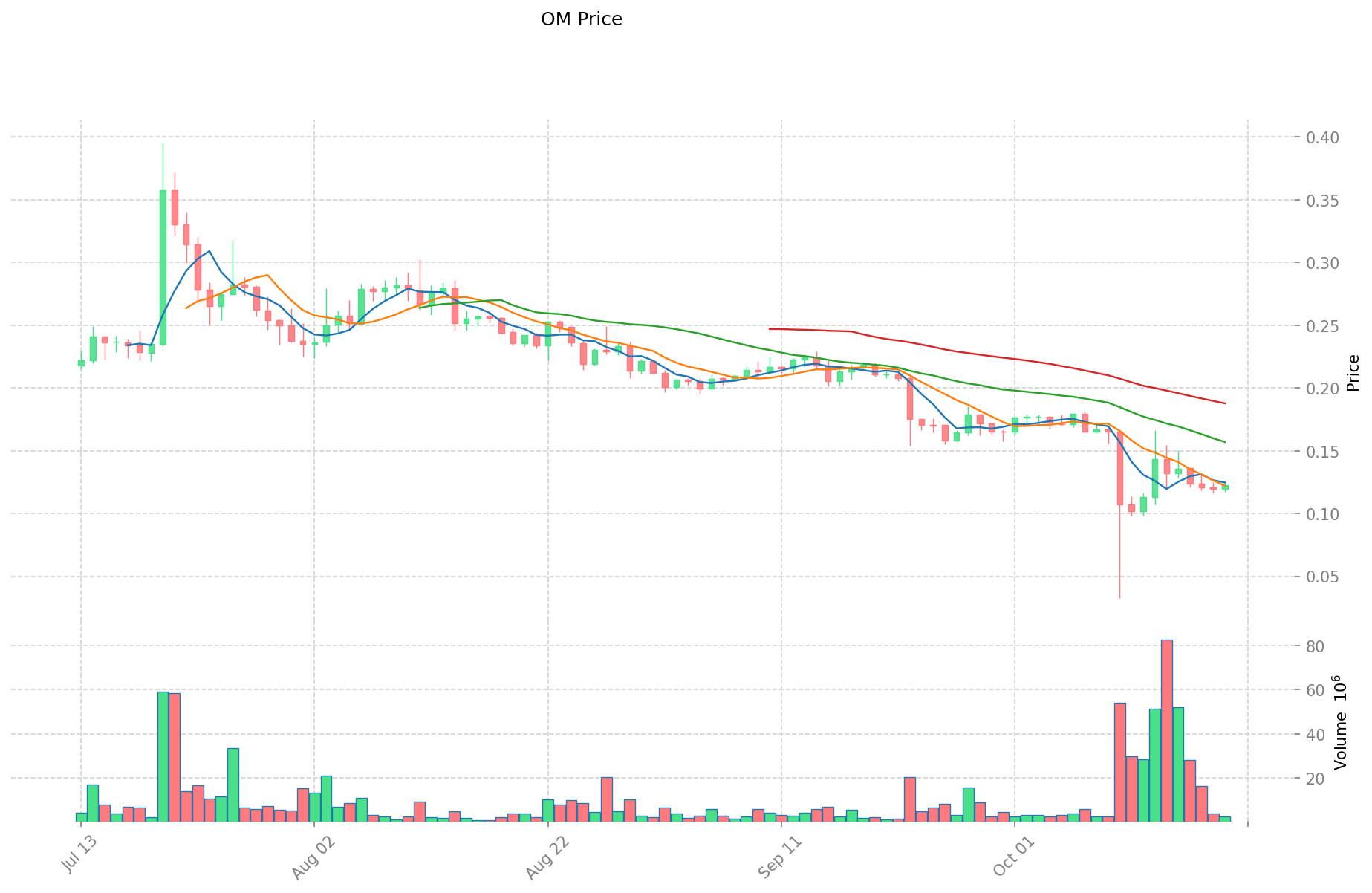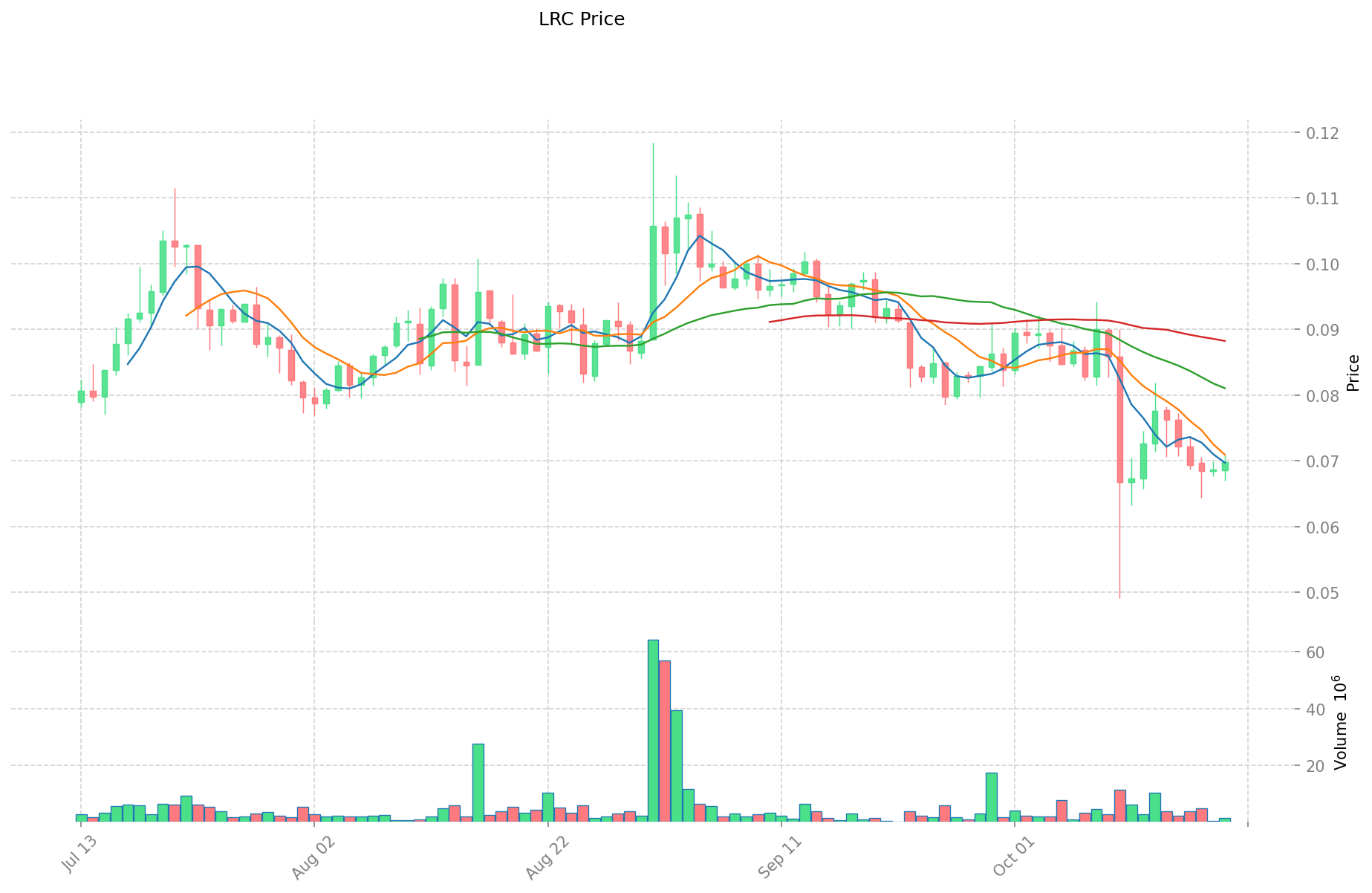OM vs LRC: The Battle for Operational Excellence in Modern Manufacturing
Introduction: OM vs LRC Investment Comparison
In the cryptocurrency market, the comparison between MANTRA (OM) vs Loopring (LRC) has been an unavoidable topic for investors. The two not only show significant differences in market cap ranking, application scenarios, and price performance but also represent different positioning in the crypto asset space.
MANTRA (OM): Launched in 2020, it has gained market recognition for its focus on security-first RWA Layer 1 blockchain technology.
Loopring (LRC): Since its inception in 2017, it has been hailed as a pioneer in decentralized exchange protocols, offering zero-risk token exchange models.
This article will comprehensively analyze the investment value comparison between MANTRA and Loopring, focusing on historical price trends, supply mechanisms, institutional adoption, technical ecosystems, and future predictions, attempting to answer the question investors care about most:
"Which is the better buy right now?"
I. Price History Comparison and Current Market Status
MANTRA (OM) and Loopring (LRC) Historical Price Trends
- 2021: LRC reached its all-time high of $3.75 on November 10, 2021.
- 2023: OM hit its all-time low of $0.01726188 on October 13, 2023.
- Comparative analysis: In the recent market cycle, OM has fallen from its all-time high of $8.99 to a current price of $0.1227, while LRC has declined from its peak of $3.75 to $0.06964.
Current Market Situation (2025-10-20)
- OM current price: $0.1227
- LRC current price: $0.06964
- 24-hour trading volume: OM $333,568.26 vs LRC $99,446.87
- Market Sentiment Index (Fear & Greed Index): 29 (Fear)
Click to view real-time prices:
- View OM current price Market Price
- View LRC current price Market Price


II. Core Factors Affecting the Investment Value of OM vs LRC
Supply Mechanism Comparison (Tokenomics)
- OM: Total supply of 10 billion tokens with a deflationary mechanism through token burns
- LRC: Maximum supply of 1.375 billion tokens, with deflationary mechanics including buyback and burn using protocol fees
- 📌 Historical Pattern: Deflationary supply mechanisms have historically supported price stability during market downturns, with LRC's lower maximum supply potentially creating stronger scarcity value.
Institutional Adoption and Market Applications
- Institutional Holdings: LRC has gained more institutional recognition through its integration with Ethereum and the GameStop NFT marketplace partnership
- Enterprise Adoption: LRC has stronger enterprise integration through zkRollup technology implementation in payment systems, while OM's cross-chain capabilities show promise for interoperability solutions
- Regulatory Attitudes: Both tokens face similar regulatory scrutiny as utility tokens in DeFi ecosystems, though LRC's closer alignment with Ethereum may provide some regulatory clarity advantage
Technology Development and Ecosystem Building
- OM Technology Upgrades: Cross-chain capability and enhanced liquidity aggregation algorithms to improve swap efficiency across blockchain networks
- LRC Technology Development: zkRollup technology advancements for greater transaction throughput and lower fees, with Layer 2 scaling solutions for Ethereum
- Ecosystem Comparison: LRC has stronger positioning in the Ethereum DeFi ecosystem with established DEX infrastructure, while OM offers broader multi-chain compatibility across more diverse blockchain networks
Macroeconomic Factors and Market Cycles
- Inflation Environment Performance: LRC's deflationary mechanism and lower total supply may provide better inflation resistance during economic uncertainty
- Macroeconomic Policy Impact: Both tokens show sensitivity to interest rate changes and USD strength, with high correlation to broader crypto market movements
- Geopolitical Factors: OM's cross-chain capabilities may provide advantages in fragmented regulatory environments, while LRC benefits from Ethereum's established global presence
III. 2025-2030 Price Prediction: OM vs LRC
Short-term Prediction (2025)
- OM: Conservative $0.08491 - $0.1213 | Optimistic $0.1213 - $0.143134
- LRC: Conservative $0.0445632 - $0.06963 | Optimistic $0.06963 - $0.0738078
Mid-term Prediction (2027)
- OM may enter a growth phase, with prices expected in the range of $0.0992156368 - $0.162891344
- LRC may enter a volatile phase, with prices expected in the range of $0.040782952485 - $0.106355542755
- Key drivers: Institutional capital inflow, ETF developments, ecosystem growth
Long-term Prediction (2030)
- OM: Base scenario $0.1842639840594 - $0.205 | Optimistic scenario $0.205 - $0.235857899596032
- LRC: Base scenario $0.102672802162317 - $0.11 | Optimistic scenario $0.11 - $0.114993538421795
Disclaimer: These predictions are based on historical data and current market trends. Cryptocurrency markets are highly volatile and subject to rapid changes. This information should not be considered as financial advice. Always conduct your own research before making investment decisions.
OM:
| 年份 | 预测最高价 | 预测平均价格 | 预测最低价 | 涨跌幅 |
|---|---|---|---|---|
| 2025 | 0.143134 | 0.1213 | 0.08491 | 0 |
| 2026 | 0.16394908 | 0.132217 | 0.11238445 | 8 |
| 2027 | 0.162891344 | 0.14808304 | 0.0992156368 | 21 |
| 2028 | 0.20057847768 | 0.155487192 | 0.13838360088 | 27 |
| 2029 | 0.1904951332788 | 0.17803283484 | 0.1637902080528 | 46 |
| 2030 | 0.235857899596032 | 0.1842639840594 | 0.173208145015836 | 51 |
LRC:
| 年份 | 预测最高价 | 预测平均价格 | 预测最低价 | 涨跌幅 |
|---|---|---|---|---|
| 2025 | 0.0738078 | 0.06963 | 0.0445632 | 0 |
| 2026 | 0.088214247 | 0.0717189 | 0.066698577 | 2 |
| 2027 | 0.106355542755 | 0.0799665735 | 0.040782952485 | 14 |
| 2028 | 0.09875072161515 | 0.0931610581275 | 0.0894346158024 | 33 |
| 2029 | 0.10938971445331 | 0.095955889871325 | 0.052775739429228 | 37 |
| 2030 | 0.114993538421795 | 0.102672802162317 | 0.085218425794723 | 47 |
IV. Investment Strategy Comparison: OM vs LRC
Long-term vs Short-term Investment Strategy
- OM: Suitable for investors focused on cross-chain capabilities and ecosystem potential
- LRC: Suitable for investors seeking Ethereum ecosystem integration and DEX infrastructure
Risk Management and Asset Allocation
- Conservative investors: OM: 30% vs LRC: 70%
- Aggressive investors: OM: 60% vs LRC: 40%
- Hedging tools: Stablecoin allocation, options, cross-token portfolios
V. Potential Risk Comparison
Market Risk
- OM: Higher volatility due to lower market cap and trading volume
- LRC: Dependency on Ethereum ecosystem performance and adoption
Technical Risk
- OM: Scalability, network stability across multiple chains
- LRC: Reliance on zkRollup technology, potential smart contract vulnerabilities
Regulatory Risk
- Global regulatory policies may impact both tokens differently, with LRC potentially benefiting from closer alignment with Ethereum's regulatory status
VI. Conclusion: Which Is the Better Buy?
📌 Investment Value Summary:
- OM advantages: Cross-chain capabilities, potential for broader blockchain interoperability
- LRC advantages: Established position in Ethereum DeFi ecosystem, zkRollup technology for scalability
✅ Investment Advice:
- New investors: Consider a balanced approach with a slight preference towards LRC due to its established ecosystem
- Experienced investors: Explore OM for its growth potential in cross-chain solutions while maintaining LRC exposure
- Institutional investors: Evaluate both tokens based on specific portfolio needs, with LRC offering more immediate institutional recognition
⚠️ Risk Warning: Cryptocurrency markets are highly volatile. This article does not constitute investment advice. None
VII. FAQ
Q1: What are the main differences between MANTRA (OM) and Loopring (LRC)? A: MANTRA (OM) focuses on cross-chain capabilities and security-first RWA Layer 1 blockchain technology, while Loopring (LRC) specializes in decentralized exchange protocols and zkRollup technology for Ethereum scaling.
Q2: Which token has performed better historically? A: Loopring (LRC) reached a higher all-time high of $3.75 in November 2021, compared to MANTRA's (OM) all-time high of $8.99. However, both have seen significant declines since their peaks.
Q3: How do the supply mechanisms of OM and LRC compare? A: OM has a total supply of 10 billion tokens with a deflationary burn mechanism, while LRC has a maximum supply of 1.375 billion tokens with deflationary mechanics including buyback and burn using protocol fees.
Q4: Which token has stronger institutional adoption? A: Loopring (LRC) has gained more institutional recognition through its integration with Ethereum and partnerships like the GameStop NFT marketplace.
Q5: What are the key technological developments for each token? A: OM is developing cross-chain capabilities and enhanced liquidity aggregation algorithms, while LRC is advancing zkRollup technology for greater transaction throughput and lower fees on Ethereum.
Q6: How do the 2030 price predictions compare for OM and LRC? A: The base scenario for OM in 2030 is $0.1842639840594 - $0.205, while for LRC it's $0.102672802162317 - $0.11. The optimistic scenarios are $0.205 - $0.235857899596032 for OM and $0.11 - $0.114993538421795 for LRC.
Q7: What are the main investment risks for each token? A: OM faces higher volatility due to lower market cap and trading volume, while LRC's main risk is its dependency on Ethereum ecosystem performance and adoption. Both face regulatory risks, with LRC potentially benefiting from closer alignment with Ethereum's regulatory status.
Share
Content